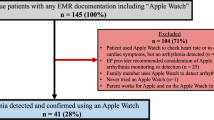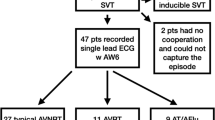Abstract
The development of smart technologies paves the way for new diagnostic modalities. The Apple Watch provides an FDA approved iECG function for users from 22 years of age. Yet, there are currently no data on the accuracy of the Apple Watch iECG in children. While arrhythmias are a frequent phenomenon in children, especially those with congenital heart disease, the increasing spread of smart watches provides the possibility to use a smart watch as mobile event recorder in case of suspected arrhythmia. This may help to provide valuable information to the treating physician, without having the patient to come to the hospital. Necessary treatment adjustments might be provided without timely delay. The aim of this study was therefore to evaluate the agreement of measured values of rate, interval, and amplitude with those obtained by a diagnostic quality ECG recording to an Apple Watch iECG in children with and without congenital heart disease. In this prospective, single-arm study, consecutive patients aged 0–16 years presenting to the Heart Center Leipzig, Department for pediatric cardiology were included. After obtaining informed consent from participants’ parents, a 12-lead ECG and an iECG using an Apple Watch were performed. Cardiac rhythm was classified, amplitudes and timing intervals were measured and analyzed in iECG and 12-lead ECG for comparability. These measurements were performed blinded to the patients’ history by two experienced pediatric cardiologists. Patient demographic data, medical and cardiac history were assessed. 215 children between 0 and 16 years were enrolled. Comparison of amplitudes and timing intervals between ECG and iECG showed excellent correlation (K > 0.7, p < 0.01) in all parameters except for the p-waves. Automatic rhythm classification was inferior to manual interpretation of ECG / iECG, while iECG interpretation was reliable in 94.86% of cases. The study demonstrates equal quality of the Apple Watch derived iECG compared to a lead I in 12-lead ECG in children of all age groups and independent from cardiac anatomy.



Similar content being viewed by others
References
Samol A, Bischof K, Luani B, Pascut D, Wiemer M, Kaese S (2019) Single-lead ECG recordings including Einthoven and Wilson leads by a smartwatch: a new era of patient directed early ECG differential diagnosis of cardiac diseases? Sensors 19(20):4377
Drexler M, Elsner C, Gabelmann V, Gori T, Münzel T (2020) Apple Watch detecting coronary ischaemia during chest pain episodes or an apple a day may keep myocardial infarction away. Eur Heart J 2020:290
https://www.accessdata.fda.gov/cdrh_docs/pdf18/DEN180044.pdf. Accessed 17 Feb 2020
Berger S, Dubin AM (2010) Arrhythmogenic forms of heart failure in children. Heart Fail Clin 6(4):471–481
Siddeek H, Fisher K, McMakin S, Bass JL, Cortez D (2020) AVNRT captured by Apple Watch Series 4: can the Apple watch be used as an event monitor? Noninvasive Electrocardiol 2020:e12742
Yerasi C, O’Donoghue S, Satler LF, Waksman R (2020) Apple Watch detecting high-grade block after transcatheter aortic valve implantation. Eur Heart J 41(10):1096
van der Linde D, Konings EE, Slager MA, Witsenburg M, Helbing WA, Takkenberg JJ (2011) Birth prevalence of congenital heart disease worldwide: a systematic review and meta-analysis. J Am Coll Cardiol 58(21):2241–2247
Kline J, Costantini O (2019) Arrhythmias in congenital heart disease. Med Clin North Am 103(5):945–956
Behzadi A, Shamloo AS, Mouratis K, Hindricks G, Arya A, Bollmann A (2020) Feasibility and reliability of SmartWatch to obtain 3-lead electrocardiogram recordings. Sensors 20(18):5074
Funding
This project has received funding from the Leipzig Heart Institute GmbH.
Author information
Authors and Affiliations
Contributions
CP study design and conduction, critical revision of manuscript. PK/MK study conduction and paper draft. RG/FTR critical revision of manuscript. AS study planning. AB/ID draft and critical revision of manuscript. SM/AM study conduction and paper revision. FM/MW study design and critical revision of manuscript. FL paper draft.
Corresponding author
Ethics declarations
Conflict of interest
None.
Ethical Approval
Approved by the University of Leipzig Ethics Committee.
Additional information
Publisher's Note
Springer Nature remains neutral with regard to jurisdictional claims in published maps and institutional affiliations.
Rights and permissions
About this article
Cite this article
Kobel, M., Kalden, P., Michaelis, A. et al. Accuracy of the Apple Watch iECG in Children With and Without Congenital Heart Disease. Pediatr Cardiol 43, 191–196 (2022). https://doi.org/10.1007/s00246-021-02715-w
Received:
Accepted:
Published:
Issue Date:
DOI: https://doi.org/10.1007/s00246-021-02715-w




